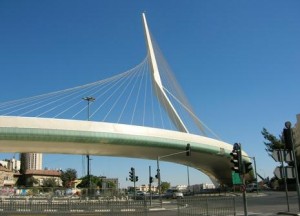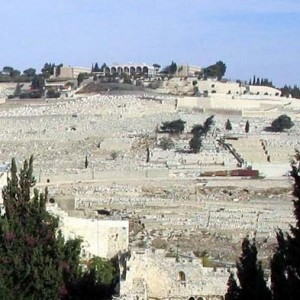Monday, September 17, 2012. It’s the first day of the Jewish New Year – Rosh Hashanah. Translated it means “head of the year.” It’s different from Dec 31st in that it is more of a testimonial of completing a year (in one piece) and preparing anew for the coming year. The period between Rosh Hashanah and Yom Kippur, the holiest of Jewish days (Day of Atonement) is devoted to admitting imperfection, asking God and ordinary folks forgiveness for any transgressions, and preparing to start life with a clean slate.
Deep in prayer with a prayer shawl (tallit) and tefillin (small leather boxes containing prayer scrolls)
We decided to take a bike ride this morning while it is still very quiet outside. Observant Jerusalemites go to temple; secular Jerusalemites celebrate the holiday by eating and relaxing. Most everything is closed. By 7:30AM we were riding along the tram tracks. The tram does not run on Shabbat and holidays, so there’s no traffic with which to contend. We rode to the Old City (east) by way of the “string” bridge (sometimes called the Harp bridge to symbolize King David’s harp).
The string (harp) bridge
The ride was great. A few taxis here and there, people walking to temple, tourists meandering about and some cyclists who had the same idea that we did. We entered the Old City through the New Gate, which leads to the Christian Quarter. We followed the alleyways that lead down (and I do mean down) to the quiet, almost secluded, Armenian Quarter.
Once in the Armenian Quarter, we followed the alley along the Old City wall south, then east toward the Jewish Quarter stopping periodically to climb a rampart on the wall to view the eastern and southern part of the city outside the wall. At one spot there was a breathtaking view of the Mount of Olives.
Mount of Olives
The Mount of Olives (Har HaZeitim in Hebrew and Jebel az-Zeitun in Arabic) is very important to both Jews and Christians. The New Testament contains many instances of Jesus visiting this site. The Garden of Gethsemane is at the foot of the Mount. Christian tradition has it that Jesus gave an end-of-time prophesy from this location and ascended into heaven from this site. According to Jewish tradition, the Messiah will appear here and bring the dead back to life. Because of this it has been used as the holiest of Jewish cemeteries for the last 3,000 years. The hillside is covered by thousands of gravestones (more than 150,000) and contains many burial caves. Former Israeli Prime Minister Menachem Begin asked to be buried at this sacred site rather than at the Mount Herzl national cemetery. Even from our distant vantage point we could see people wandering the cemetery on this early morning, as is the custom on Rosh Hashanah.
We ended the ride at one of the lowest parts of the Old City – the entrance to the Western Wall – THE holiest site for Jews. It was very quiet except for the prayer chanting (davening) and the singing of Jewish liturgical prayers. There was also the faint sound of the blowing of the Shofar (ram’s horn) in the distance.
L’Shonah Tova Tikatevu V’Tehatemu (“May you be inscribed and sealed in the book of life for a good year.”)



